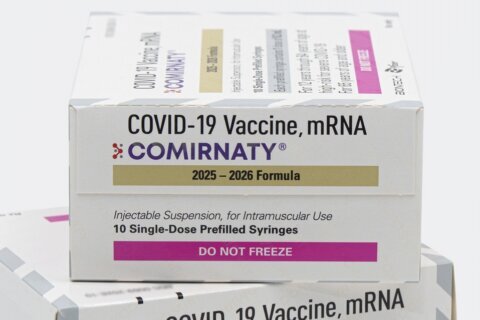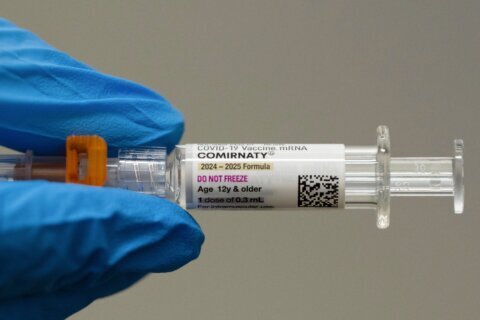Amid a nationwide coronavirus uptick and full-blown outbreaks in some states where the overall pace of vaccinations have lagged, there is growing concern about the more transmissible delta variant of the virus driving caseloads and serious illness.
In the D.C. area, where COVID-19 vaccinations have outpaced the national average, there are growing indications of the spread of the delta variant and what appears to be a modest uptick in coronavirus cases compared to the surges elsewhere. In Virginia, there has also been a slight increase in COVID-19-related hospitalizations.
But health officials across the region continue to stress that the vast majority of coronavirus-related cases, hospitalizations and deaths are found among people who have not been vaccinated. Experts continue to say the most effective way to protect yourself — even against the delta variant — is to get vaccinated.
“The important thing and the bottom-line message is that what we have seen is the vaccines are still effective against the delta variant and especially in preventing severe disease,” said Dr. Jinlene Chan, deputy secretary for public health services with the Maryland Department of Health.
Vaccines blunt delta impact in Md. — so far
In Maryland, the seven-day average of new daily cases bottomed out early last month at fewer than 60. However, the case rate has been ticking back up recently, hitting 179 earlier this week. On Thursday, Maryland recorded more than 300 new daily cases for the first time since May.
“We are seeing an uptick in our numbers and seeing an increase in delta variant as well,” Chan said. “But in this area, Maryland has lagged behind the rest of the country and in a good way, and I think it’s in large part because of the people who have gotten vaccinated.”
Maryland has just under 58% of its population fully vaccinated and more than 70% of adults fully vaccinated, which is the highest vaccination rate in the D.C. area.
Chan said those vaccination rates have “blunted the impact of this new variant here in Maryland.”
Still, there is some indication in the data that the variant of concern is penetrating the D.C. region, although perhaps not to the degree in other parts of the U.S.
Variants of concern are identified by an additional layer of lab testing that involves sequencing the genetic structure of the virus, which can take time to fully account for.
The CDC tracks variants of concern and provides reports every two weeks with data running through the prior week. The most recent data runs through July 3. According to that data, the delta variant makes up more than 61% of variants of concern nationally. (Testifying before a Senate panel this week, CDC Director Dr. Rochelle Walensky said an even more recent snapshot showed the delta variant accounted for 83% of variant cases sequenced across the U.S.)
In the broad health region that includes Virginia, Maryland and D.C. — as well as Pennsylvania, West Virginia and Delaware — delta makes up 45.3% of specimens sequenced, far below the national figure.
But the presence of the delta variant regionally has grown more than three-times-over compared to what it was June 19, the last time CDC reported the data when the delta variant made up just 12% of the identified variant cases in this health region.
“We have been fortunate to have the higher vaccination rates, and we have lagged behind in terms of seeing the impact of delta, but I would say at this point, it is the predominant variant in Maryland and in this region,” Chan said.
What makes the variant so concerning is that it appears to spread more easily.
“It is definitely more transmissible,” Chan said, citing research out of the UK and Israel and early studies in the U.S. “There’s some early evidence to suggest that it may cause more hospitalizations,” but that’s still early, she added.
However, all indications, so far, are that the current crop of vaccines are effective.
“Everything that we’ve seen so far says that the vaccines — the current vaccines that we have — are effective against the delta variant,” she said.
- Sign up for WTOP alerts
- Sign up for WTOP’s coronavirus email newsletter
- Latest vaccination numbers in DC, Maryland and Virginia
- Va. Dept. of Health recommends mask use for all inside elementary schools
Looking for more information? D.C., Maryland and Virginia are each releasing more data every day. Visit their official sites here: Virginia | Maryland | D.C.
Concern about breakthrough cases
As virus caseloads have shot up elsewhere across the country, there have been increasing questions — and even alarm — about breakthrough cases, which involve infections of people who are fully vaccinated.
Late last month, Maryland Health Secretary Dennis Schrader provided data to Maryland lawmakers showing that, since May 10, 97% of all COVID-19 cases in the state as well as 89% of hospitalizations and 89% of deaths involved people who weren’t vaccinated.
Overall, since the beginning of vaccination efforts in the state late last year, there have been just under 2,500 known COVID-19 cases involving people who were fully vaccinated — meaning they were infected more than two weeks after their final vaccine dose — out of 3.5 million people who have been vaccinated in that same time frame.
All told, there were more than 190,000 total COVID-19 infections in Maryland in that same time frame.
D.C. health officials are set to release comprehensive data on COVID-19 cases in the District on Thursday afternoon.
Virginia sees uptick in cases, hospitalizations
In neighboring Virginia, health officials, earlier this month, released a dashboard to track breakthrough cases.
Overwhelmingly, the vast majority of people getting infected with the coronavirus, getting seriously ill and dying are all unvaccinated, according to the data.
Since late January, 99.4% of cases in Virginia, 98.6% of hospitalizations, and 99.% of deaths have occurred in people who have not been vaccinated, according to the health department data.
There are occasional “breakthrough” cases of the virus in people who are vaccinated, but even in those cases the vaccine provides strong protection against becoming very sick or ending up in the hospital, doctors say.
Like Maryland, Virginia has seen a modest uptick in cases recently.
The seven-day average of new daily cases is on the rise. Last month, the seven-day average fell below 200 for a few weeks for the first time. More recently, however, the number has ticked back up to above 400.
Still, the seven-day average of cases is far below the January 2021 peak, when vaccines were not widely available and the average number of cases in the commonwealth was 20 times higher — hitting about 6,100 new daily cases at the peak.
Virginia has also seen hospitalizations “inching back up,” said Julian Walker, spokesman for the Virginia Hospital and Health Care Association, which maintains an online dashboard tracking daily hospitalization rates.
In the last week or so, hospitalizations of COVID-19 patients or patients with pending test results have ticked up to above 300 for the first time in a month. That’s “significantly lower” than a peak of 3,200 hospitalizations in January.
“But at the same time, those numbers are elevated from even a few weeks ago, when we were in the low 200s for daily hospitalizations for COVID-19,” he added. “That is a concern because we monitor these numbers everyday,” he said. “But for perspective, they are much, much lower than they were in these previous peaks … So comparatively speaking, things are still pretty stable.”
Walker, who attributed the increase to a variety of factors, including greater social activity and likely the presence of the delta variant, said it’s still too early to see if the recent uptick in hospitalization is part of a more sustained trend or more of a blip.








